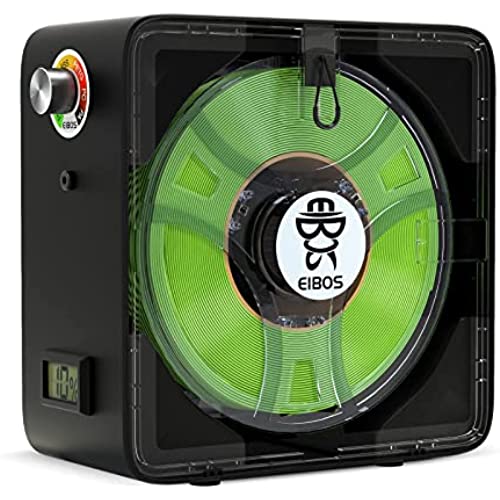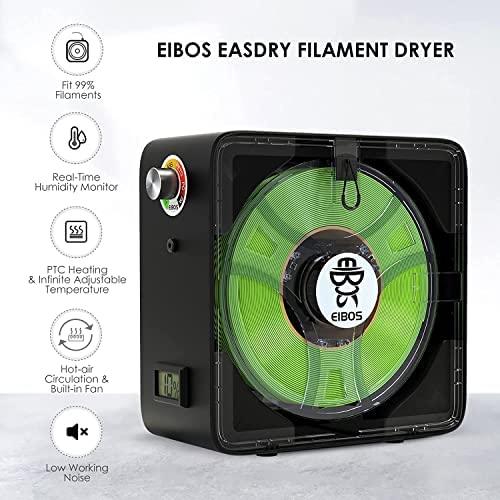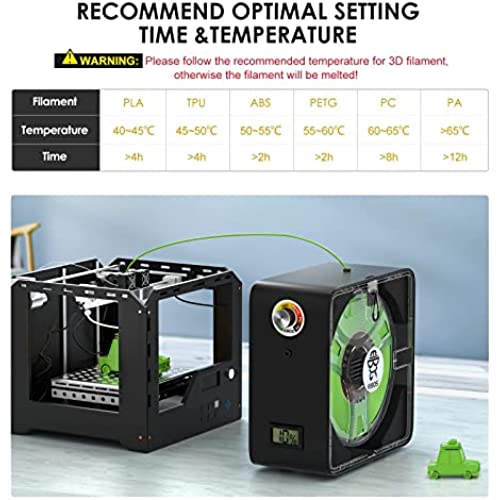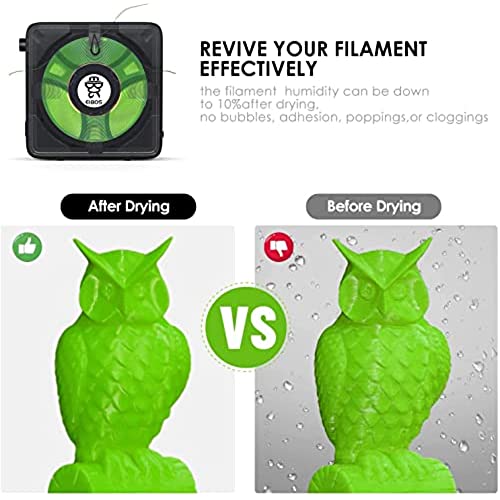













【EIBOS Official】3D Printer Filament Dryer Easdry, 3D Printer Filament Dryer Box with Fan, Adjustable Temperature, Humidity Control & Spool Holder, Compatible with 1.75mm 2.85mm 3.00mm Nylon, PLA, ABS
-

Joey
> 3 dayIve been using Eibos Easdry for a couple weeks now and I can confidently say its the best filament dryer Ive used so far. Ive used the Sunlu S1 and this one runs circles around it. The biggest difference between the two is that the Eibos has a fan to evacuate moist air, whereas the S1 just heats up the spool and has no air circulation. This greatly reduces the time it takes to dry your filament. The next biggest difference is that the Eibos is much easier to use. You dont have to mess around with 2 buttons that dont have labels like on the S1, you just turn the knob to the material you want to dry and it heats it to the right temperature for that material. The only downside here is that theres no timer, just on or off. But the manual it comes with does tell you how long you should be drying each material. The Eibos Easdry also has a hygrometer on the front so you can see the humidity level inside the box. If you want to print while drying you can do that also because it has two holes you can run filament out of. Eibos also sells vacuum bags for storing filament after drying which I recommend too. Overall this is a better product than the competition for the same price, so its hard to beat.
-

DRN
> 3 dayThis is a very nice filament dryer, especially considering the price point. The operation is simple: open the side door and place your roll of filament on the central spool holder (making sure to feed your filament out of one of three holes if you are using it as you print) and close the door. Turn the dial knob to the filament type (PLA, PETG, ABS, etc.) and then turn the unit on. It will then circulate warm air to dry your filament until you turn it off, and you can watch the humidity level drop on the built in sensor. The fan runs pretty quietly and the unit does not become overly warm to the touch on the outside (at least on the PLA settings I run at). There is a little area inside where you can place desiccant bags - either to dry them out as well, and/or to help keep the filament dry while the unit is turned off. The side door is clear so you can monitor your filament. When set to the high end of the PLA range, I found the internal temperature was 40-50C and varied somewhat from place to place within the dryer. Are there downsides to this dryer? Well yes. First, there is no operation timer as on some dryers. Which means you cant just set it to run for 4 or 8 hours and have it shut off automatically. Honestly, thats a feature I would have liked since I often like to set rolls to dry overnight. Second, the very convenient dial knob for filament type means you dont know exactly what temperature youre setting it to. So you will have to check the temperature manually if you are unsure or concerned (or just trust the unit to do its thing). Despite a couple of downsides, Im still rating this as 5-stars due to the nice build quality, quiet fan, simple-to-use operation, built in humidity monitoring, and reasonable price.
-

John Johnson
> 3 dayIt is simple to use. Open the door, pop in the filament, close the door , turn it on and set the temperature. It uses a fan to circulate outside , heated, air forcefully and evenly throughout the inside. It gets plenty hot to dry the filament. There is a place to tuck in some drying breads, too. There are holes to allow filament to be used while it is in the dryer. I havent used it in this manner, yet. Having filament on a pressboard spool, I felt a good amount of drag, when I tested how it moved. If I want to use it with that fashion of spool, I may have to find a way to reduce the friction for it to turn easily enough. (MAYBE a sheet of PTFE around the spool arm) I havent tried a plastic spool. I suspect it will turn with less friction and be OK. It just makes a fan sound. It isnt too loud and distracting. It, also, has a humidity percentage display ; which is handy. Its been highly reviewed pin YouTube. I agree. This is a very good dryer.
-

Chris M.
> 3 dayThis is really great for my prints! Dries out my filament really well and doesn’t take up much space at all! - Other filament dryers have a pop up lid that I always felt didn’t have enough heat distribution, so I would always reach in and turn the spool a bit to make sure all of it was being dried. With this I haven’t once felt the need to turn it! - Does take a couple desiccant packs inside to absorb, but has active heat and air circulation! - Digital hygrometer on the side - Definitely has done very well for me with TPU and Nylon! Compact and performs great! 10/10 would get this again!
-

Adrian
Greater than one weekThis is the 3rd filament dryer Ive used and my favorite so far. Ive come to prefer the side load, over the more common top load. The top load dryers usually have a flimsy lid and can be a pain to close correctly. The side door on the EIBOS dryer is thick and easy to put in place. Using the dryer is easy, just plug it in, turn the dial to the desired setting and flip the switch on the rear of the dryer. Theres a small red LED that illuminates through the bottom rear of the side panel when the dryer is on, but you can hear the circulation fan also. The fan is pretty quiet and doesnt have an annoying pitch. While running the outside of the dryer does get warm, but gets hot on the front. My pics show the front of the dryer after running it at the high end of the PLA setting for about 2 hours. The bottom of the dryer got warm, but not nearly as much as the front. I lost the pics of the filament temp measurements, but it was pretty consistent and fell within the desired range for PLA. The humidity monitor is, like most filament dryers Ive seen, powered by a battery. I didnt see a switch to turn it off, so its always on. Having it hardwired, or at least having an on/off switch, would be nice. If I had to get picky, a digital temp display might be nice too at this price point. Although the dial has worked fine and I havent found myself wishing for a temp display. Overall Im really liking the EIBOS Easydry filament dryer and have been going for it over the other two I have.
-

Adriano
> 3 dayWorks well, but the humidity sensor is terribly inaccurate. 5 mins after you put some filament in the screen will read 10% (and thats as low as itll go) even though theres no way its actually at 10%. So I recommend you get buy a wifi or zigbee or zwave humidity sensor and you throw it inside with your filament. On the bottom left hand side of the drying chamber theres a small unused bit of space measuring roughly 30mm x 50mm that you can use to put a custom sensor in. For reference on the different when the dryer reads 10% my sensor is usually reading ~35%. Additionally the fan isnt super loud but it isnt quiet either so you probably wont want to have this on top of your desk if youll be spending a lot of time around it.
-

Miss Beulah Hane
> 3 dayThis dryer solved so many problems! Ive tried to build my own dry box with axles and adapters for filament to come out, but Ive never been able to get one to work right. Now, I just use this dryer to hold my filament and I dont have to worry about humidity, filament getting caught, or the roll not spinning. I still keep my filament in a well-sealed box with silica gel so it all stays dry, but now when I have to take a roll out I know I can keep it dry and clean, even during days-long prints. And since its enclosed, it keeps all the dust and dog fur off the filament. Overall, this is exactly what I needed and at a good price.
-

NorthernVA
> 3 day* For printing environments which benefit from side loading spools, you should consider this printer * detachable power cable is a second benefit over the completions * if you prefer a dial potentiometer to adjust the units drying temperature, this is the unit for you! however… * in my printing environment they didn’t work out + these units require the inside of the filament spool to rotate around a fixed plastic ‘axel’. Bottom rollers as commonly used by other solutions at the same price point at not present. * my experience was that several of my spools of brand new PLA would break off causing overnight jobs to stall * the friction tugging against the filament had other negative impacts of printing * nothing against eibos, just this particular design; as I have to work ‘double roll’ solution with front and back rollers beneath each spool and it works very well. * for fem filament dryers I prefer a digital thermostat with lcd readout ) as is standard on other models) that displays bith the user adjusted target temp and the sampled temp.
-

Jay
> 3 dayBeen through a number of dryers and this is the best one. Just a simple dial to control the thermostat, a well built enclosure, and a heating coil that is intelligently placed. What more could you want.
-

Brian
> 3 dayOverall it works, but this model doesnt shine a light on their double spool model. I really liked the double spool model and when my 3d printers multiplied (as they tend to do), i got the single model. I like the compact form factor and ease of use. I dont like that it is slower to dry than the double and I think its because of air flow. I also find the ball bearing rollers on the double model work better on both cardboard and plastic spools than the single model. The single model just hangs the spool on a round, non-rotating plastic piece. If I hadnt used their other model I might not even have noticed these things because it does work and I am going to use it, but if your budget can afford the double model, get it instead.
